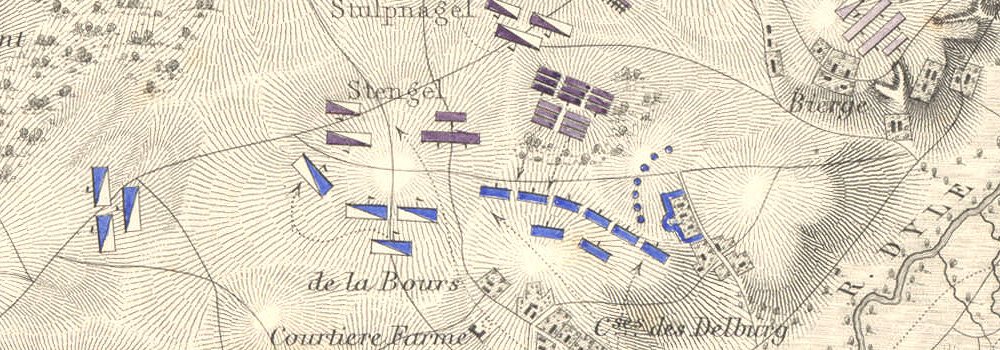Osterman-Tolstoi had under his command in the area most of his 2nd
division- 3 regiments totalling 9 battalions (a fourth regiment of 3
battalions had been detached), 2 cavalry squadrons (having detached 4
others), 1 regiment of cossacks, 14 heavy guns (a position battery) and 6
light guns (part of a light battery). The bulk of these troops were strung
in redoubts along a ridge running from roughly opposite Pomiechowo through a
pine wood to a ravine flanking the town of Czarnowo (where he placed his
heavy artillery) about 2500 yards up the Bug from the islands opposite
Okunin. Below this ridge to the Ukra and Bug rivers the land, like that on
the island, was a miserable flat and marshy partially-wooded floodplain.
On the night of the 20th of December Morand had expelled the Russian
detachment from, and occupied, the remainder of the island. On the morning
of the 23rd of December Napoleon came to observe the position and make plans
for the crossing. Davoutâs troops executed Napoleonâs detailed plan exactly.
On the night of the 23rd of December, three battlions of Morandâs troops
formed into columns and detached voltigeurs to cover the emplacement of
Morandâs artillery at the riverbank. These voltigeurs then proceeded to
cross the remaining portion of the river in boats brought up from elsewhere
on the Bug. With the voltigeurs across, three bridges were put into place at
the heads of the three columns. These columns then crossed, followed by the
17th Legere regiment and then by three cavalry squadrons and finally by the
remainder of Morandâs division.
Following Morand, a battalion detachment of Gudinâs division under Petit,
one of his brigade commanders, crossed at the left bridge and moved along
the Ukra towards Pomiechowo, supported by a light company from Friantâs
division under Perrin which had crossed about 100 yards up from the island
and more importantly by Friantâs guns which threatened to fire into the
flank of any counter-attack against their front.
Morand formed in echelon back from right to left, with the 17th Legere now
leading the way. In this manner the low ground was rapidly cleared of
Russians and Morand advanced to the assault on Czarnowo.
The 17th Legere hurried well forward of the remaining French and burst
almost by suprise into the batteries in front of this town, only due to lack
of support to be driven away again by Russian bayonnets. As Morandâs main
body came up his 30th regiment organized a more thorough attack. One
battalion turned the left of the Russian line at Czarnowo through the ravine
along the Bug, a second battalion turned the Russian right near the town
through the pine wood and the third battalion advanced on the front of the
position. The remainder of the division followed in support with cavalry to
the rear of the center. The first attacks were turned back by the crack
troops of the 2nd division, but it was apparent that the position must
eventually fall to French numbers so Osterman-Tolstoi was forced in
characteristically Russian fasion to dispatch his heavy guns towards
Nasielsk to avoid their loss.
On the French left Petitâs battalion advanced under supporting fire from
Friantâs guns and were thus able to capture the line of redoubts on their
front, from which the light guns had been withdrawn to Czarnowo just in time
to avoid capture. The French lacked troops on this front for a pursuit and
this made the Russians realize how weak this sector was. Accordingly the
Russian cavalry was sent against Petit, who resisted them and their
supporting infantry largely through flanking artillery fire from Pomiechowo
but also through further re-inforcements (probably Petitâs four remaining
battalions) from the remainder of Gudinâs division which continued to pour
across the Bug at Okunin.
Before dawn Czarnowo finally succumbed to French numbers.
Osterman-Tolstoiâs detached troops (a regiment of infantry and some cavalry
squadrons) arrived allowing him to pull out of the line towards Nasielsk
following the route taken by his heavy guns as the French spread onto the
plateau beyond the ridge the Russians had originally occupied. Friantâs
division came over the bridges around Okunin about this time and took over
the pursuit, passing the lines about daybreak and reaching Nasielsk about noon.
All in all the action had lasted about nine cold, dark, wet and miserable
hours from Morandâs deployment after dark at seven the previous evening
until about four the next morning, still well before dawn, when
Osterman-Tolstoi ordered the final withdraw. Osterman-Tolstoi reported his
losses at 500, although other sources have confirmed his Russians had a
total of 1,392 men killed and wounded. Davout claimed the loss of 807 men,
although since he did not include the cavalry nor Petitâs troops his total
loss was probably higher than the Russian total. Davoutâs loss in officers
was especially high, as expected for a well-led night attack. But the
results justified Napoleonâs confidence in Davoutâs troops evidenced by his
decision to make a night attack. By dong so he avoided the losses which
would have associated with constructing bridges and advancing over the low
ground all under the fire of the Russian artillery.
